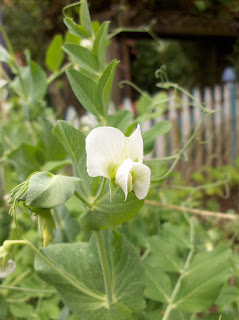I recently picked up the book "Wild Fermentation" by Sandor Ellix Katz. Wow! This book is inspiring and challenging in all the right ways!
It all starts off with the Foreword by Sally Fallon. In it she writes, "Sandor Katz has labored mightily to deliver this magnum opus to a population hungry for a reconnection to real food and the process of life itself. For fermented foods are not only satisfying to eat, they are also immensely satisfying to prepare. FRom the first successful batch of kombucha to that thrilling taste of homemade sauerkraut, the practice of fermentation is one of partnership with microscopic life. This partnership leads to a reverence for all the processes that contribute to the well being of the human race, from the production of enzymes by invisible bacteria to the gift of milk and meat from the sacred cow."
Imagine, Americans waking up to the reality that they are living in a world of industrialized, generic, chemical, food and wanting to know what food is really supposed to taste like, how its made, and where they fit into the process!
Sandor spends a large portion of time and chapters explaining the importance of microorganisms (bacteria and yeasts) in the process of life. He explains that we're all in a symbiotic relationship with this microflora from digestion to healing to fermenting to compost and decaying. "Without them, there could be no other life."
He goes on to talk about how destructive we've all become with or obsession for "hygiene" and "cleanliness" and its subsequent use/abuse of antibacterial soaps, disinfectants, antibiotics, pasteurization and sterilization. We've somehow developed a very skewed look at what we call "germs". These aren't our enemies! They're our greatest allies! Bacteria and yeasts make foods digestible (both in our stomachs and in the environment before we eat the foods). They help us adapt to our environments, they create vitamins for our consumption, produce antioxidants as a by-product of fermentation, and make some foods and waters safe to consume. Try as we might, we can never get rid of all the microorganisms around us. They are everywhere. In trying, we're only disturbing the balances.
Sandor's study on the origins of fermentation shows us that its one of the oldest processes known to humans. He speculates that it's quite likely that we've been fermenting foods since before we practiced agriculture and possibly since before we learned how to use fire! Indeed, the fact that we choose to talk about fermentation and the population of yeasts and bacteria as "cultures" speaks loudly to the fact that they and us grew together.
Its frightening to read about the cultural homogenization that is occurring right now. We've come to expect that our foods will look the same way and taste the same way every time we taste them regardless of where we travel to eat them. A cola drink you purchase in Boston is expected to taste and look the same as the cola drink you purchase in Seattle. Same with fries. Same with breads. Same with all our other foods. Is it any wonder McDonald's and other similar fast-food businesses have done so well to sell such poor quality food? Sandor talks about this concept and expends on it talking about how so many of the distinctive cultures and ethnicities that we can clearly conjure up in our minds each have their own particular food. The French have strong cheeses. The Greek and other Baltic nations have strong yogurts and kefirs. They are known for these foods and we associate these countries as being cultured. The United States is known for its bland beers (Budweiser) and its bland cheese (Velveeta and Kraft). Is there any question of why Americans are void of a strong national culture or identity?
If our lack of culture isn't enough, we're pushing these ideas on others as well. Mass-marketing and mass-production have created a market that frowns on the distinctive foods that don't have a widely-recognized name (like Coca-Cola, Wonder Bread, Kraft, etc). Sandor writes that "this is the homogenization of culture, a sad, ugly process by which languages, oral traditions, beliefs, and practices are becoming extinct every year, while ever-greater wealth and power is concentrated in fewer hands. Wild fermentation is the opposite of homogenization and uniformity, a small antidote you can undertake in your home, using the extremely localized populations of microbial cultures present there to produce your own unique fermented foods. What you ferment with the organisms around you is a manifestation of your specific environment, and it will always be a little different. Perhaps your homemade sauerkraut or miso will conform perfectly to your image and expectation of them... More likely, they will possess some quirky anomaly that will force you to adjust your image and expectation. Do-it-yourself fermentation departs from the realm of uniform commodity." DIY fermentaiton puts you back in the process of creation and also helps build food-security. You know what you are eating. You know where it came from. You know that if something happens you will still have access to it.
I have been excited about getting this book for 6 months as I waited for a used copy of it to turn up. One never did; I had to buy the book new. This speaks to the quality of what it contains. After reading the book and looking over the many recipes it contains, I've decided that I want to ferment my way through it. We already brew our own kombucha and beers. Now we're going to try our hand at other fermented foods too! We'll post the results of each ferment here, so keep an eye out!
-Fauna

"Wild Fermentation" is available from Chelsea Green Publishing.










